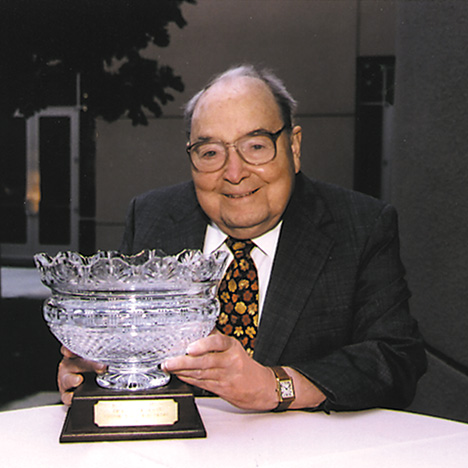The Ultimate Gemologist:
A Tribute to Richard T. Liddicoat
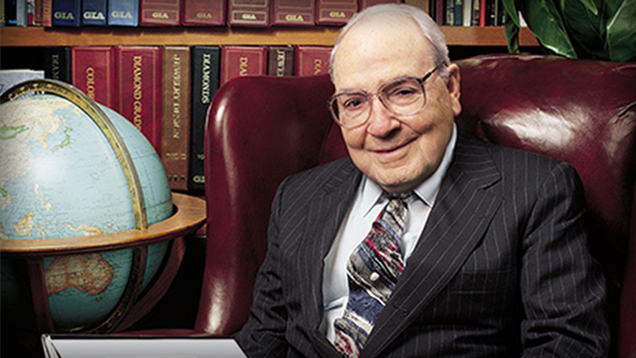
With this special issue of Gems & Gemology, we celebrate the 50th anniversary of Richard T. Liddicoat (figure 1) as editor and now editor-in-chief of GIA’s quarterly professional journal. This festschrift, or special celebratory issue, provides a welcome opportunity to review his contributions to gemology, especially in five main areas: education, diamond quality grading, gem identification, instrument development, and global information outreach. Following the lead of GIA’s founder, Robert M. Shipley, Liddicoat positioned GIA as a leading international educational institution, grading laboratory, manufacturer of gem instruments, and research center. Those who have had the privilege to know and work with him have been able to expand the frontiers of gemology “by standing on the shoulders” of this giant.
THE EARLY YEARS
Robert M. Shipley founded the Gemological Institute of America in Los Angeles, California, in 1931. His vision was to create an institution that would promote professional education in gemology for jewelers in the United States, allowing them to buy and sell with increased knowledge and confidence. At the time, no such organization existed in the U.S. In the early 1930s, Shipley—working in partnership with his wife Beatrice—stimulated interest among jewelers by traveling across the U.S. to retail stores, where he would preach the benefits of gemological education. In the evenings in his hotel room, Shipley would write courses for jewelers to take through correspondence. He established the beginnings of an educational institute in Los Angeles with a small staff that grew slowly over the next decade as resources allowed. Together, he and his staff created lessons, gave instruction on gemstones and their properties, and began the process of helping jewelers correctly identify the gem materials they handled (Gilbert, 1977).By 1940, Shipley realized the need for additional leadership at GIA. His son, Robert Shipley Jr., who had worked closely with him in recent years, had signed up for military service. Shipley contacted Chester B. Slawson, a mineralogy professor at the University of Michigan in Ann Arbor who was co-author of one of the leading gemology texts at that time, Gems and Gem Materials (Kraus and Slawson, 1939), as well as one of GIA’s educational advisors. In his letter, Shipley asked Slawson to recommend a mineralogist to join the GIA faculty. Dr. Slawson suggested one of his graduate students, Richard T. Liddicoat. As Liddicoat recalled, “Slawson thought that I was wedded to graduate school and headed for a Ph.D. in mineralogy, so he didn’t think I’d be interested. But he showed the letter to me anyway. After years of school, I was ready to do something else. The idea of gems and Los Angeles really had appeal” (Youngs, 1980, p. 40).
Liddicoat drove with his wife Mary Imogene (“Gene”) Liddicoat to Cincinnati, Ohio, for an interview with Robert Shipley and then-chairman of GIA’s Board of Governors, Edward Herschede. He found both men impressive, with Shipley especially charismatic in his passion for education and gemstones.
Richard Thomas Liddicoat Jr. was born on March 2, 1918, in Kearsarge, Michigan, the son of a professor of engineering at the University of Michigan, Ann Arbor, and Carmen Beryl Williams Liddicoat. Both his grandfathers were miners from Cornwall, England, who had immigrated to the upper Keweenaw Peninsula of Michigan in the latter half of the 19th century. These two men inspired their grandson to explore the geology of his surroundings. Liddicoat attended the University of Michigan, from which he received a bachelor’s degree in geology in 1939 and a master’s degree in mineralogy in 1940.
On June 28, 1940, Liddicoat joined the GIA staff as assistant director of education, beginning a 60+ year career of service to GIA and the jewelry industry (see highlights in the timeline). In those days, the Institute was a family affair: Beatrice Shipley managed the office, while Shipley Jr. focused on developing gemological instruments and techniques, as Shipley Sr. continued with education and attracting jewelers to the GIA programs. (Also involved was Beatrice’s nephew Al Woodill, who briefly worked at GIA in 1940 –1941. In 1947, Woodill became the executive head of GIA’s sister organization, the American Gem Society [AGS], which Shipley Sr. had established in 1934 as a professional guild of jewelers.)
Liddicoat’s first priority was to take the GIA courses, which he completed in less than three months. As an instructor, he was responsible for grading GIA correspondence exams—on average, 225 tests per week. “When I first came out here, I used to grade all the papers. They were all essay questions in those days. I would take all the papers home with me, one day a week, and just keep going until I finished them. Sometimes, it was pretty late when I got through with them all,” Liddicoat later recalled (Youngs, 1980, p. 40).
Within a year of his hiring, Liddicoat was named director of education, the first person outside the Shipley family to hold a major position within GIA.
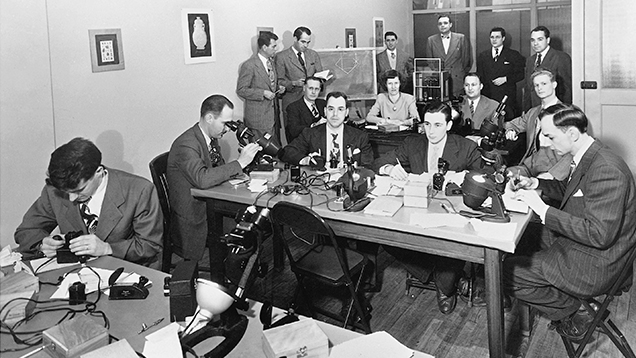
CONTRIBUTIONS TO GEMOLOGICAL EDUCATION
One of Liddicoat’s first innovations in gemological education was an intensive one-week class that was launched at the AGS Conclaves in Philadelphia and Chicago in 1942 (Federman, 1985a). He developed this class to enable students to complete the prerequisite Diamond and Colored Stone training of Shipley’s original fundamental course in a one-week resident education format. This class also gave jewelers the opportunity to work with equipment in a classroom setting under the guidance of GIA instructors (figure 2). Liddicoat would become a mainstay as a speaker and instructor at these Conclaves, and in 1997 the AGS honored him for having attended 50 of them (“A special tribute…,” 1997).During World War II, from August 1942 until January 1946, Liddicoat left GIA to serve in the U.S. Navy. After working for a few months in a shipyard, he eventually was assigned to the Pacific fleet as a weather officer on aircraft carriers and at Pearl Harbor (“Liddicoat resumes work at headquarters… ,” 1946).
Upon his return from military service in February 1946, Liddicoat was named director of research and, later, director of education and research. The March 1946 issue of the AGS magazine Guilds described him as “an extremely popular leader and instructor who proved his ability to project his personality into instruction in the mail courses” (“Liddicoat resumes work at headquarters…,” 1946, p. 5). In June 1946, he helped launch the first evening gemology class in Los Angeles, which allowed local GIA correspondence students to gain hands-on experience while continuing to work in their jewelry stores during the day.
Recognizing the need for an inexpensive handbook for GIA students, Shipley assigned Liddicoat the task of creating it. This new gem identification reference book was the first directed to the needs of the practicing gemologist. Closely tied to the GIA course work, it also was unique in organizing the gemstones by color. Liddicoat spent almost a year on the book, dictating sections to his wife Gene in the evening (R. T. Liddicoat, pers. comm., 2002). In August 1947, the first edition of his Handbook of Gem Identification was published (figure 3). This book, one of the first to include photomicrographs of inclusions as identifying characteristics, supported GIA education classes that increasingly focused on gem identification and gem-testing instrumentation. It continues to be one of the most widely used textbooks in gemology, now in the fourth printing of its 12th edition.
Beginning in 1948, GIA granted the title gemologist to those students who had completed all of the home study courses, and awarded the title graduate gemologist (G.G.) when students completed the additional class training and passed the 20-stone exam. Since the inception of the graduate gemologist diploma, approximately 25,000 students have gained this important industry recognition. Later in 1948, Shipley turned over much of the day-to-day operation to Liddicoat (“Executive staff changes…,” 1948). GIA student enrollment grew substantially during the postwar years, influenced in large part by the G.I. Education Bill, by which the U.S. government gave financial support to its military veterans. To meet the needs of a growing student population, more instructors were added to the GIA staff to teach the students both in “extension” classes at the Los Angeles headquarters and through home study education. During the latter half of the 1940s, the GIA staff doubled from 20 to 40. When the G.I. Bill’s benefits ended in the early 1950s, however, enrollment fell off sharply, and GIA faced a financial challenge just as Shipley was planning to retire.
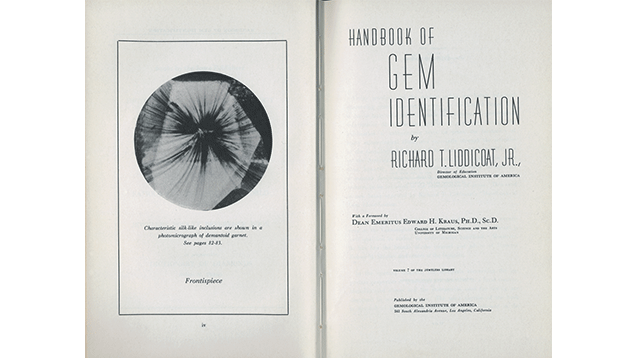
Liddicoat, Shipley’s handpicked successor, became executive director of GIA on April 1, 1952. He moved quickly to address the Institute’s financial problem by focusing GIA’s education on a key concern of jewelers: diamond grading.
In the early 1950s, jewelers were calling for a standardized diamond grading system to counter the fanciful and often inconsistent terminology then being used to describe polished diamonds. Such descriptions only made effective communication between dealers and customers more difficult. Liddicoat tackled the problem with Los Angeles colleagues Lester Benson and Joe Phillips, with input from the New York laboratory’s Bob Crowningshield (then director of GIA’s Eastern Headquarters and Gem Trade Laboratory and later vice president of GTL Gem Identification) and Bert Krashes (who retired in 1987 as managing director of the GIA Gem Trade Laboratory). Together, they developed a diamond grading and evaluation appraisal program based on the color, clarity, cutting, and carat weight of diamonds. To unveil the class, they decided to go to the heart of the diamond district in New York.
Liddicoat and Crowningshield taught the first one-week classes on the new diamond grading system in April 1953 at the Roosevelt Hotel in New York City (figure 4 shows a one-week class from 1954). This diamond grading class became part of GIA’s regular gemology program in 1955. Liddicoat also established a new traveling one-week class, Diamond Evaluation, to bring an understanding of the benefits of this new diamond grading terminology to jewelers throughout the United States (Shuster, in press). Glenn Nord, who was then taking the new diamond course, recalls: “GIA was introducing an entirely new culture to the jewelry industry with its education, and it was Dick Liddicoat’s leadership that helped people accept these changes” (pers. comm., 2002).
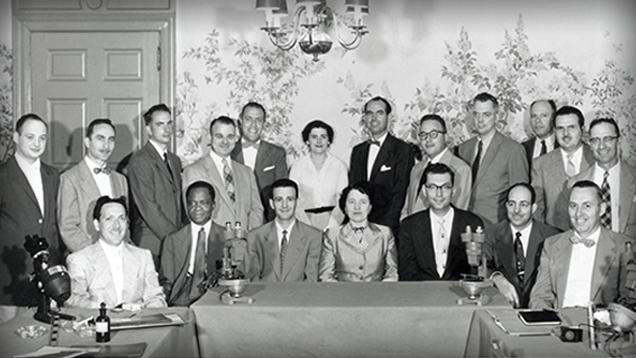
In 1955, 14 of the 45 lessons—or nearly a third of GIA’s home study diamond courses—were rewritten. Liddicoat personally revised 10 of them. During the same time period, he expanded the education program by adding a jewelry retailing home study course. The first jewelry design course, long presented in Brooklyn by Christian Jakkob, was turned over to GIA and reorganized by Lester Benson, a GIA educator and inventor. Liddicoat reflected, “I always had the feeling that once the gemology program was in place, we should offer a complete curriculum for the retail jeweler” (pers. comm., 2001).
To further meet the need for a standardized terminology for its students and members of the trade, GIA began working on a glossary of diamond terms. Out of these efforts came the first Diamond Dictionary (1960), by Lawrence Copeland with Richard Liddicoat and other staff members (see Copeland et al., 1960; figure 5). Later that same decade came Liddicoat and Copeland’s The Jewelers’ Manual (again, see figure 5). Published in 1964, it was an expansion of Shipley’s earlier Jewelers Pocket Reference Book (1947).
Liddicoat worked closely with Lester Benson to produce a revised course structure for the gemology program (“GIA courses to have new look,” 1958). In 1962, after providing a variety of supplemental classes for students to obtain additional training time, GIA began to offer a full-time resident G.G. program in Los Angeles. Before then, students could obtain this diploma only through home study, supplemented by short-term classes.
During this same period, Liddicoat (1962) wrote an article for Gems & Gemology on the “rapid sight” system for judging diamond cut quality. According to Nord (pers. comm., 2002), “After Dick developed the system, he and I would sit and trade diamonds back and forth for hours. We could judge so many factors, including proportions and angles, very accurately. It was an important teaching tool that is still a key part of the diamond program today.”
In the late 1960s and early 1970s, Liddicoat oversaw Nord’s development of corporate training classes for Zales, one of the largest retail jewelry store chains in the U.S., a program that continues today with a number of major businesses.
Also in the late ‘60s, Liddicoat made several trips to Japan in an effort to glean the information necessary to develop a cultured pearl course and, ultimately, GIA’s first pearl grading system.
Richard Liddicoat took Shipley’s concept of home study (or “distance”) education beyond North America when, in 1970, he sent Nord to Israel to teach the first diamond course outside the U.S. A year later, with Liddicoat’s endorsement, GIA courses were being taught in Japan (figure 6). Yoshiko Doi, a former GIA staff member who had returned to Japan, and Kenzo Yamamoto established the Association of Japan Gem Trust (AGT), a non-profit organization with exclusive rights to administer GIA courses in Japanese (“Focus on: Kenzo Yamamoto,” 1984). Doi translated all course materials into Japanese, thus beginning GIA’s ability to offer courses internationally and in other languages. Currently, GIA programs are offered in 11 countries outside the U.S.
Early GIA efforts to establish a system to describe the quality of polished diamonds can be traced back to the 1930s, when Robert M. Shipley Sr. and De Beers collaborated to develop the concept of the “Four Cs”: color, clarity, cut, and carat weight. In 1939, the AGS adopted this terminology for describing diamonds. A 1941 article in Guilds describes a nine-year process by GIA to develop a unit for color grading diamonds and efforts to standardize color grading (“Standardization of color grading…,” 1941). That same year, Shipley Sr. and Liddicoat published an article on diamond grading that described the use of a standardized light source (the Diamolite) and a prototype colorimeter for grading diamond color against a graduated color scale (Shipley and Liddicoat, 1941). This same research by Shipley, Dorothy Jasper Smith, and Liddicoat led to the creation of the first master set of color comparison diamonds for diamond grading in 1941 (R. T. Liddicoat, pers. comm., 2002).
Nevertheless, as indicated above, ongoing confusion and inconsistency in diamond grading terminology brought about the demand for a new vocabulary to more clearly express the color, clarity, and cut of individual diamonds. As Bert Krashes (pers. comm., 2001) notes, “There was a lot of ambiguity and confusion when it came to trade grading of diamond color and clarity, so there was a significant need for GIA to create this system.”
Liddicoat became the architect of the GIA diamond grading system, developing a practical approach to quality grading colorless to light yellow polished diamonds on the basis of color, clarity, and cut. A central feature was the D-to-Z color grading system for faceted, colorless to light yellow diamonds, which comprise the vast majority of diamonds seen in the trade. The letter D was chosen as the starting point (colorless) to avoid confusion with other, more loosely defined classification systems being used, which typically began with the letter A (King et al., 1994). Liddicoat remembers that at the time the diamond companies had their own descriptions, which included A and AA, so it was felt that D would be less confusing (R. Liddicoat, pers. comm., 2001).
Having discussed quality grading of diamonds at earlier AGS Conclaves, Liddicoat introduced the GIA diamond grading system at the 1953 Conclave in Philadelphia. “Richard Liddicoat deserves the credit for developing the diamond grading system. He had some assistance from Lester Benson, but it was mainly Liddicoat” (B. Krashes, pers. comm., 2002).
Beginning in 1953, GIA instructors taught this grading system to hundreds of students so they could evaluate their own diamonds. Subsequently, many of these students requested that GIA set up a procedure whereby they could submit their grading worksheets, and eventually the diamonds themselves, for an independent assessment.
Bert Krashes recalls the transition (pers. comm., 2002): “It began as a service we offered students. After they took the courses, whether correspondence or one-week classes, we agreed to double-check their grading of their own diamonds. We would make our comments on the diamond worksheets. Eventually, word reached the industry that we were capable of doing this work, and soon there was a demand for a more formal presentation.” Liddicoat teamed with Crowningshield, Krashes, and Eunice Miles to design and develop the Diamond Grading Report (Christie, 1988), the first of which was issued in 1955.
UNLOCKING THE MYSTERIES: GEM IDENTIFICATION AND GEMS & GEMOLOGY
Gem Identification. When Robert M. Shipley set up his Los Angeles laboratory in the early 1930s, the Institute’s resources were devoted to identifying gems and to documenting the properties and techniques that would aid in their separation (Jasper, 1948). Late in 1948, following the unexpected resignation of Dr. Mark Bandy as director of the fledgling New York laboratory, Shipley assigned Liddicoat to New York to lead the expansion of that new branch. Liddicoat and his wife Gene drove across the country and arrived there in early January 1949. While Liddicoat and Crowningshield took care of the gem identifications and taught classes at night, Gene was the office administrator (R. T. Liddicoat, pers. comm., 2002). The resources of the New York operation were further enhanced when the Gem Trade Laboratory, which had been established by A. E. Alexander, was turned over to GIA in October of that same year. As director of GIA New York and the GIA Gem Trade Laboratory, Liddicoat was responsible for integrating the facilities of the two labs (“Richard T. Liddicoat Jr.appointed…,” 1952). The early identification work was typically a group effort among staff members who became known as the “Liddicoat brain trust” (Federman, 1985a).By the 1970s, the GIA Gem Trade Laboratory staff was examining large numbers of gemstones, including the grading of diamonds and the identification of colored stones and pearls. Sensing the need for a group of scientists who would focus on the many emerging technical challenges in gemology, Liddicoat formally established the current GIA Research Department in 1976. Dr. D. Vincent Manson, formerly curator of gems and minerals at the American Museum of Natural History, was named its director.

Liddicoat became editor of Gems & Gemology on Robert Shipley’s retirement in 1952, with Jeanne G. M. Martin as his associate editor. Liddicoat himself led a procession of notable mineralogists, gemologists, and other scientists who contributed groundbreaking articles to the journal. Subsequent associate editors included Dr. Robert Gaal (1973–1977) and John I. Koivula (1978–1980). In 1981, Alice Keller was brought on as the journal’s managing editor to oversee its redesign; she was subsequently promoted to her current position as editor and director.
Liddicoat encouraged Crowningshield and Benson to write their “Highlights at the Gem Trade Lab” columns—Crowningshield in New York and Benson in Los Angeles—which debuted in the Winter 1958–59 issue of Gems & Gemology (R.T. Liddicoat, pers. comm., 2002). Liddicoat took over the Los Angeles column in 1962 (figure 7). “Highlights at the Gem Trade Lab” later became the Gem Trade Lab Notes section, which continues to describe interesting gem materials that have been seen in the GIA Gem Trade Laboratory.
Five times in the last decade, Gems & Gemology has won the American Society of Association Executives Gold Circle Award for best peer-review journal in America. Liddicoat continues to serve as editor-in-chief, writing editorials, reviewing books and articles, and setting editorial policy for the award-winning publication.
CONTRIBUTIONS TO GEMOLOGICAL INSTRUMENTATION
Liddicoat presided over four decades of innovation in gem instrument development at GIA, and established gem instruments as one of the Institute’s highest priorities (Federman, 1985b). In addition to his early work with Shipley to develop the Diamolite (figure 8), Liddicoat worked with various GIA scientists on a number of other instruments. Liddicoat’s own scientific background enabled him to foster the development of instruments such as the prism spectroscope and the ProportionScope (GIA Diamond Grading course, 1994). His objective throughout instrument development at GIA was to provide jewelers with practical tools that could help them in the day-to-day operation of identifying gemstones.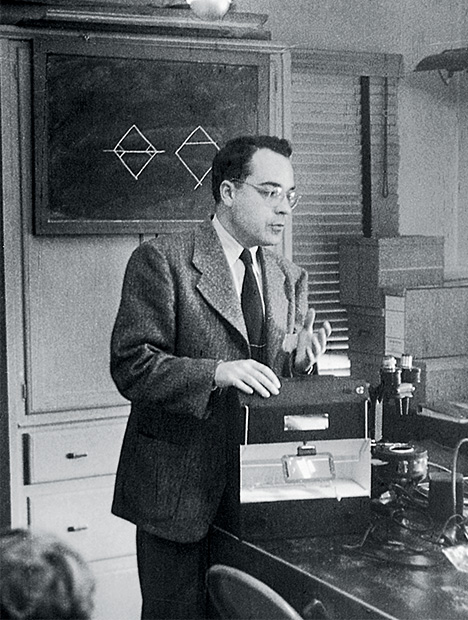
GLOBAL INFORMATION OUTREACH
In the early 1980s, Liddicoat championed the use of computer networks to connect jewelers and gemologists to a vast array of knowledge. In a 1985 interview in Modern Jeweler, he predicted that one day jewelers across the country would be connected to GIA through such a network: “Imagine not having to leave your store or business to consult with GIA” (Federman, 1985c, p. 56). That idea became reality in 1986 with the creation of GIA-Net under the leadership of Dennis Foltz, then director of education and operations at GIA, and has evolved today into GIA Virtual Campus (for students) and the GIA Web site: http://www.gia.edu. Approximately 150,000 people access the GIA Web site monthly.Liddicoat’s contributions to spreading gem and jewelry knowledge were immortalized with the creation of the Richard T. Liddicoat Gemological Library and Information Center in 1989. Although Robert Shipley had built the beginnings of a library from the very first days of GIA, Liddicoat was the one who envisioned a world-class, state-of-the-art library that would serve not only GIA staff and students, but also jewelers, gemologists, and consumers worldwide. This repository was greatly expanded under the direction of one of the authors (DMD) with the purchase of the 15,000-volume John and Marjorie Sinkankas Gemology and Mineralogy Library in 1988 (figure 9). Located at the Institute’s headquarters in Carlsbad, California, the Liddicoat Library is now the largest gemology and jewelry library in the world. At almost 836 square meters (9,000 square feet), it houses over 30,000 volumes and journals as well as extensive collections of photos, videotapes, and other media resources.
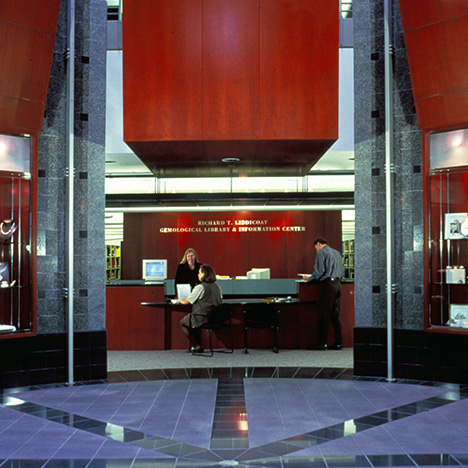
As director of education and later president, Richard Liddicoat was GIA’s ambassador to many gemology and jewelry associations. As indicated earlier, he was a mainstay at AGS Conclaves for more than 50 years, frequently accompanied by GIA’s finest gemologists (figure 10). He attended industry meetings and then incorporated the information he gathered into Gems & Gemology and the education program. He actively participated in the International Kimberlite Conferences and the International Gemmological Conferences (IGC), as well as a variety of trade association events. In 1983, Liddicoat retired as president of GIA, but was subsequently named chairman of GIA’s Board of Governors, a position that he still holds. Liddicoat is a founding member of the International Colored Gemstone Association (ICA) and the American Gem Trade Association (AGTA). In recent years, he has continued to attend trade shows and visit gem mines, in addition to his involvement with GIA and Gems & Gemology (figure 11).
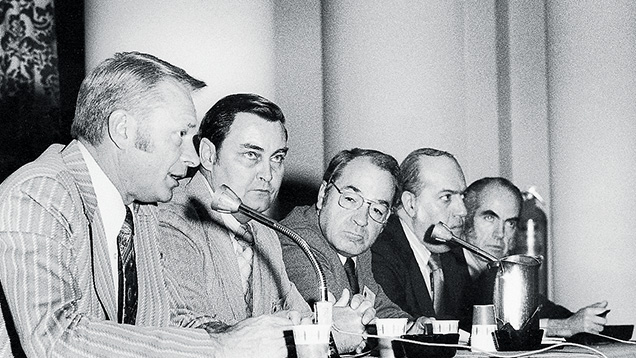
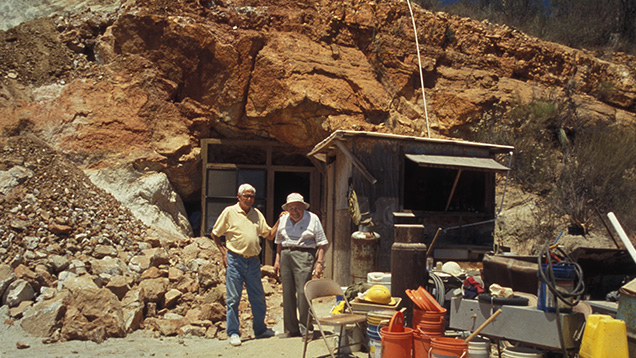
THE “FATHER OF MODERN GEMOLOGY”
In recognition of his more than 60 years of service to the gem and jewelry industry, Liddicoat has received many awards and commendations. Among the most prestigious are:- American Gem Society Honorary Certified Gemologist (1947)
- American Gem Society Robert M. Shipley Award (1976)
- Honorary Fellow of the Gemmological Association of Great Britain (1981)
- American Gem Trade Association Honorary Member (1983)
- Consolidated Jewelers Association of New York’s Man of the Year (1984)
- Modern Jeweler’s Lifetime Achievement Award (1985)
- The Morris B. Zale Lifetime Achievement Award (1987)
- Honorary Lifetime Membership of the Gem Testing Laboratory of Great Britain (1987)
- National Home Study Council’s Hall of Fame (1991)
- GIA Board of Governors’ Chairman for Life (1992)
- GIA League of Honor Lifetime Achievement Award (1995)
- American Gem Society Lifetime Achievement Award (2001)
Liddicoat received special recognition in 1977 with the naming in his honor of a new gem species of tourmaline (figure 12). Dr. Pete J. Dunn and his colleagues from the U.S. National Museum of Natural History (Smithsonian Institution; Dunn, 1977) named “the mineral liddicoatite [the calcic lithiumtourmaline end member], in recognition of his contributions to gemological knowledge and education.” Liddicoat is one of only a few gemologists ever to be so recognized (Federman, 1985a).
When Liddicoat was honored as Man of the Year by the Consolidated Jewelers Association of New York in 1984, National Jeweler publisher Milton Gralla said of him, “There is not a community of any size anywhere in the United States where one or many jewelers have not been touched, influenced, educated, upgraded or professionalized by the thinking of this particular industry leader—Richard T. Liddicoat” (“Liddicoat honored . . . ,” 1985).
In 1994, GIA established the Richard T. Liddicoat Award for Distinguished Achievement to acknowledge those GIA staff members who have provided unique talent and demonstrated unparalleled commitment to the Institute.
During his 60-plus years with the Gemological Institute of America, Richard Liddicoat has brought practical gemology to hundreds of thousands of students and industry colleagues. Just as GIA has touched the lives of thousands in the industry, so has Liddicoat with the wisdom he graciously shares. When Liddicoat received the AGS Lifetime Achievement Award on July 31, 2001 (figure 13), more than 300 jewelry industry professionals stood in ovation. GIA president Bill Boyajian said, “Richard Liddicoat’s achievements and contributions to the world of gemology and jewelry have been monumental. The living title ‘Father of Modern Gemology’ pays tribute to his success, yet only begins to describe the extent to which his efforts on behalf of an entire industry and the consuming public have changed the course of history.”
